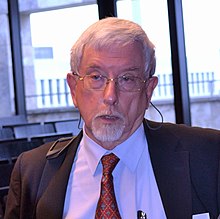Gerd R. Puin

Gerd Rüdiger Puin (born 1940) is a German scholar of
Discovery of the Sanaa manuscript

Gerd R. Puin was the head of a restoration project commissioned by the
These scriptures were written in the early Hijazi Arabic script, matching the pieces of the earliest Quranic manuscripts known to exist.[1] Some of the papyrus on which the text appears shows clear signs of earlier use, being that previous, washed-off writings are also visible on it. In 2008 and 2009, Elisabeth Puin published detailed results of the analysis of "Sanaa manuscript DAM" (dar al-makhtutat) 01.27-1, proving that the text was still in flux in the time span between the scriptio inferior and the scriptio superior of the palimpsest.[2][3]
More than 15,000 sheets of the Yemeni Quranic manuscripts have painstakingly been cleaned, treated, sorted, cataloged and photographed and 35,000 microfilmed photos have been made of the manuscripts.[1] Some of Puin's initial remarks on his findings are found in his essay titled the "Observations on Early Qur'an Manuscripts in Sana'a", which has been republished in the book What the Koran Really Says (2002), written by the Ex-Muslim author and activist Ibn Warraq. In January 2021, an interview with Puin regarding the discovery of the Sanaa manuscript was conducted by Robert M. Kerr, secretary of the INÂRAH Institute for Research on Early Islamic History and the Koran.[4]
Assessment of the Quran
In a 1999 article published in the American magazine The Atlantic, Gerd R. Puin has been interviewed and quoted as saying that:[1]
My idea is that the Koran is a kind of cocktail of texts that were not all understood even at the time of Muhammad. Many of them may even be a hundred years older than Islam itself. Even within the Islamic traditions there is a huge body of contradictory information, including a significant Christian substrate; one can derive a whole Islamic anti-history from them if one wants.[1]
The Koran claims for itself that it is 'mubeen,' or 'clear,' but if you look at it, you will notice that every fifth sentence or so simply doesn't make sense. Many Muslims—and Orientalists—will tell you otherwise, of course, but the fact is that a fifth of the Koranic text is just incomprehensible. This is what has caused the traditional anxiety regarding translation. If the Koran is not comprehensible—if it can't even be understood in Arabic—then it's not translatable. People fear that. And since the Koran claims repeatedly to be clear but obviously is not—as even speakers of Arabic will tell you—there is a contradiction. Something else must be going on.[1]
Works
- OCLC 173644215.
- OCLC 179808111. Archived from the originalon 10 May 2012. Retrieved 31 January 2012.
- Hans-Caspar Graf von Bothmer; Karl-Heinz Ohlig; Gerd-Rüdiger Puin (1999). "Über die Bedeutung der ältesten Koranfragmente aus Sanaa (Jemen) für die Orthographiegeschichte des Korans. In: Neue Wege der Koranforschung" [On the meaning of the oldest Quran fragments from Sana'a (Yemen) on the orthographic history of the Quran. In: New Ways in Quran Research] (PDF). ISSN 0937-7301. Archived from the original(PDF, 0.4 MB) on 23 December 2012. Retrieved 31 January 2012.
See also
- Patricia Crone
- History of the Quran
- Christoph Luxenberg
- Sana'a manuscript
- John Wansbrough
References
- Puin, Gerd-R. (1996). "Observations on Early Qur'an Manuscripts in Ṣanʿāʾ". In Stefan Wild (ed.). The Qur'an as Text. Leiden, Netherlands: ISBN 978-1-57392-945-5.
- ^ from the original on 25 August 2012. Retrieved 16 May 2022.
- OCLC 299070399.[permanent dead link]
- ^
Groß, Markus; Ohlig, Karl-Heinz (2009). "Ein früher Koranpalimpsest aus Ṣanʿāʾ – II. [An early Quran palimpsest from Sana'a – II. ]". In Markus Groß, Karl-Heinz Ohlig (ed.). Vom Koran zum Islam [From the Quran to Islam]. Schriften zur frühen Islamgeschichte und zum Koran [Writings on the early Islamic history and on the Quran] (in German). Vol. 4 (1st ed.). Berlin: Verlag Hans Schiler. pp. 523–581. OCLC 496960079.
- ^ Robert M. Kerr, Gerd R. Puin (13 January 2021). Discovery of Sana'a Manuscripts with Dr. Gerd R. Puin (Videotape). Retrieved 16 May 2022 – via YouTube.
- ISSN 1474-0699.
